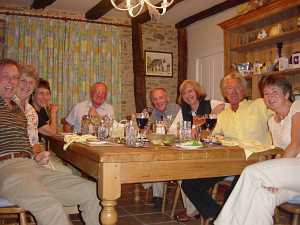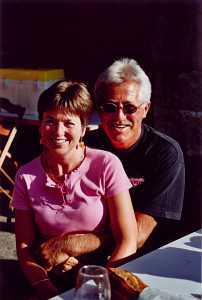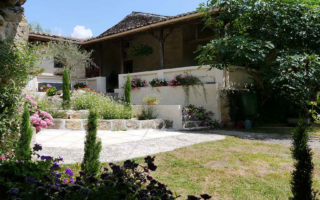Keeping cool in the kitchen


Running a B&B requires a regiment of skills
 Keith and Helen Archibald have been running a successful bed & breakfast and gîte business in the Corrèze since 2001. Throughout the main holiday season, they serve their guests breakfast every morning – and most evenings, they also produce a gourmet four-course supper. Keith tells us how they do it
Keith and Helen Archibald have been running a successful bed & breakfast and gîte business in the Corrèze since 2001. Throughout the main holiday season, they serve their guests breakfast every morning – and most evenings, they also produce a gourmet four-course supper. Keith tells us how they do it
When Helen and I first set up our bed and breakfast business three years ago, we knew we would have to produce breakfast for our guests every morning. What we had definitely not anticipated, however, was that guests would be so eager to order supper each evening, as well.
Fortunately, La Farge – our house in the Corrèze – is ideal for our B&B business. We have three guest bedrooms and bathrooms, a separate lounge for guests, a large farmhouse kitchen for meals and plenty of room left over for our own private space. On the whole, our guests are couples and adult groups – a conscious decision – and we also have an independent two-person gîte for those who prefer to self-cater.
Originally, we decided to offer guests evening meals for one simple reason – it would give us an excellent excuse to enjoy delicious food and wine in the company of interesting people. The hope was that we would also make a bit of extra money at the same time.
Catering for our guests was actually a logical and easy way for us to expand our business. We both love to cook and we both love to entertain. In addition, Helen had had more than enough experience of catering when, as a teenager, she often cooked meals for her large family – so before we even started, she knew what was going to be involved.
Getting organised
Getting ourselves and our kitchen organized was our first major task. We decided to serve the meals in the kitchen so that we could cook and entertain at the same time.
To do this, we had to make sure that we had a large enough table for the maximum number of guests (plus ourselves). But we also had to make sure that there was enough room for us to manoeuvre around the kitchen with all the guests seated around the table. Although this seems almost too obvious to mention, it really is vital if you want to serve up food without tripping over chair legs.
Another obvious point is to make sure that you have all the necessary (well-functioning) kitchen equipment and utensils. Tableware is another crucial consideration – the cutlery and crockery need to be stylish, but also durable, dishwasher-proof and easily replaceable, like the odd dropped tray of champagne glasses.
One final point is workspace in the kitchen. During a meal, you have to try not to make too much of a mess when cooking, serving up and clearing away. You can’t really load everything straight into the dishwasher with guests there, so you have to think about where everything is going to be stacked up in the meantime. Luckily, we have an area behind the fireplace in our kitchen which is out of sight of the guests.
Of course, if you prefer to serve meals away from the kitchen, the organisational considerations are different. Perhaps the most difficult problem is maintaining the ambience if you’re both in the kitchen preparing to serve up. And you also have to be prepared for guests wandering into the kitchen during or after the meal, so you need to work as tidily as possible or they might get the wrong impression.
How to get ideas
Once we had organised the practicalities, we needed to start thinking about our recipes and menus – a process we go through annually. Helen has been collecting recipes from newspapers and magazines for years (the clippings seemed to spill out of every box when we unpacked in France). She also has an incredible collection of English and French cookery books – and the Internet is an invaluable source for specific recipe information and ideas.
Because we offer a four-course meal, we need to know and plan which dishes are possible and practical well in advance of the holiday season. Each winter, we usually set aside a couple of nights a week for cooking and evaluating new dishes. We look for recipes which allow a certain amount of preparation to be done in advance and don’t entail too much cooking just before serving up.
It’s also great to produce dishes that people would rarely cook at home, so we steer clear of ‘Delia’ dishes and aim for a style that you could describe as ‘Franglais’. We also prefer recipes which will incorporate as much of our home-grown fruit and vegetable crops as possible.
If we think a certain main course will complement a particular starter or dessert, we make a note of that – but we tend not to use strategies such as a two-week rolling menu or freezing meals in advance. This is purely because you cannot cater for each guest’s likes and dislikes if you’ve already planned a rigid menu before they arrive.
We must admit that deciding on menus can sometimes be a little difficult, especially if one person is a vegetarian, for example, and others in the group don’t like tomatoes or cheese or onions.
Every guest who eats with us has a record card detailing each meal we’ve served him or her. This is proving invaluable as we build up repeat clients each year – we hope never to serve the same dish twice to the same guest. The record cards are also a good way to remember dietary requirements and likes or dislikes.
How to prepare
Once the evening menu has been planned, we have to think about shopping and allocating the various cooking tasks. The nearest supermarket is 15 minutes away, so we have to plan our time carefully, especially if we need to go further afield for specialist ingredients. We also try to prepare as much of the meal in advance during the day so that we don’t end up with a panic in the evening.
Helen tends to do most of the cooking and therefore most of the shopping. This is not sex discrimination – it’s just that she is extremely well organised, highly efficient and doesn’t need to read the recipe 10 times (unlike me). I am, however, an expert at peeling vegetables, setting the table, shining the cutlery, verifying the wine stocks and taking orders (from Helen, that is).
How to get the evening going
Each evening meal is, in effect, a glorified dinner party. Having changed into smart-casual clothes (we always try to make an effort), we start with aperitifs at 7.30pm, which are served either in the guests’ lounge or in the garden, depending on the weather. While Helen beavers away in the kitchen for half an hour, I play host and head waiter.
Helen normally serves the starters but we’re both on duty for the main course. I keep the glasses full (wine is included in the price of the meal) and try hard not to pour all our profits away with my over-enthusiastic arm. After a respectable break, we serve cheese and then dessert, as is traditional in France. Coffee rounds off the evening in the guests’ lounge, although it should be mentioned that serving digestifs with coffee is not a very good idea if you’re trying to make any money from catering.
How to end the evening
We try to round off the evening as smoothly as possible, which can sometimes be difficult if people are enjoying chatting together. It’s hard not to look at the clock, but we do have to remind ourselves that we’ve still got to clear up and prepare the breakfast table for the morning – all with the minimum of fuss and without getting to bed at the crack of dawn.
In addition, after each meal we like to appraise the cooking and the ambience. Did the guests enjoy the meal? Was there anything we should change or could do better next time? Did the timings go according to plan? Could presentation be improved? Should we try different vegetable combinations? You would be amazed to see the number of notes we add to recipes at this stage.
The next day, we sometimes ask guests for their opinions. Many have said that the fact we offer evening meals is a big selling point because many don’t want to bother driving out to a restaurant each evening (and not drink).
With this in mind, we decided that a website for our business would be the best way to present and promote our meals. We contacted the LetSites web agency (www.letsites.com) and had a website up and running within a few weeks, with a whole section dedicated to details about our catering.
How to serve breakfast after a long night
Getting up for breakfast after a late night is the hardest part of the job for me, so I’m in charge of early morning flower-watering and pool-cleaning duties. Helen, however, relishes the challenge of producing a delicious breakfast for guests, so I leave her to it. We offer a wide choice of croissants, toast, homemade jams, yoghurts, cereals and loads of fresh fruit. We steer clear of cooked breakfasts simply because of the lingering smell in the house afterwards!
Guests can choose what time they would like breakfast which means that we have to be quite flexible in the morning. We ourselves eat after the guests have finished, otherwise we can find ourselves stuck around the kitchen table socialising when we should be clearing up the breakfast things, changing beds, cleaning bathrooms, shopping, gardening, preparing for supper…
As you’ll have gathered from all we’ve said, catering for clients is extremely time-consuming and takes an immense amount of preparation for each meal to run smoothly. It’s also worth mentioning that spending a lot of time in the kitchen during the hottest time of the year can sometimes be hard, but the rewards are very high. Meals are a great way for you to get to know your guests – and happy, satisfied guests are the ones who will book again next year, which is what it’s all about!
For information about their B&B and gîte, contact Keith & Helen: www.chezarchi.com , or telephone: (00 33) 5 55 28 54 52, or email: info@chezarchi.com
For information about website design, contact Charlie: www.letsites.com , or telephone: (00 33) 5 59 85 17 92, or email: info@letsites.com
Share to: Facebook Twitter LinkedIn Email
More in b&b, businesses, estate agents, food, garden, wine, work
By FrenchEntrée
Leave a reply
Your email address will not be published. Required fields are marked *



